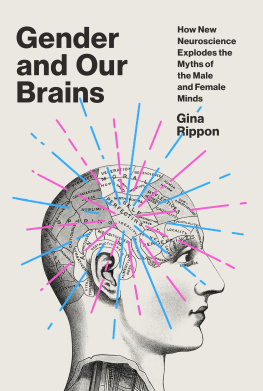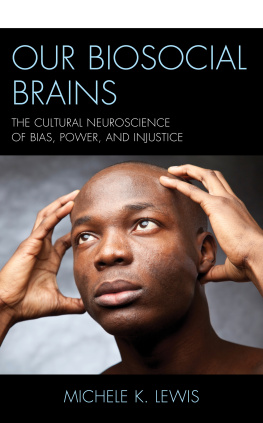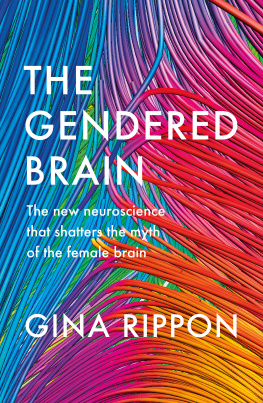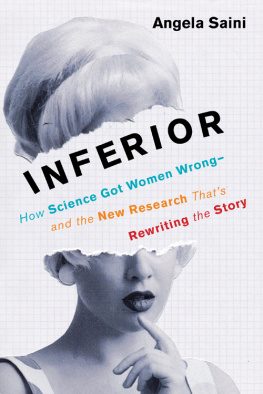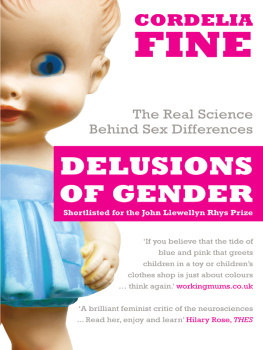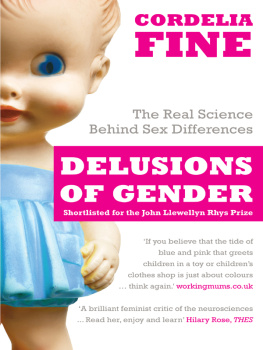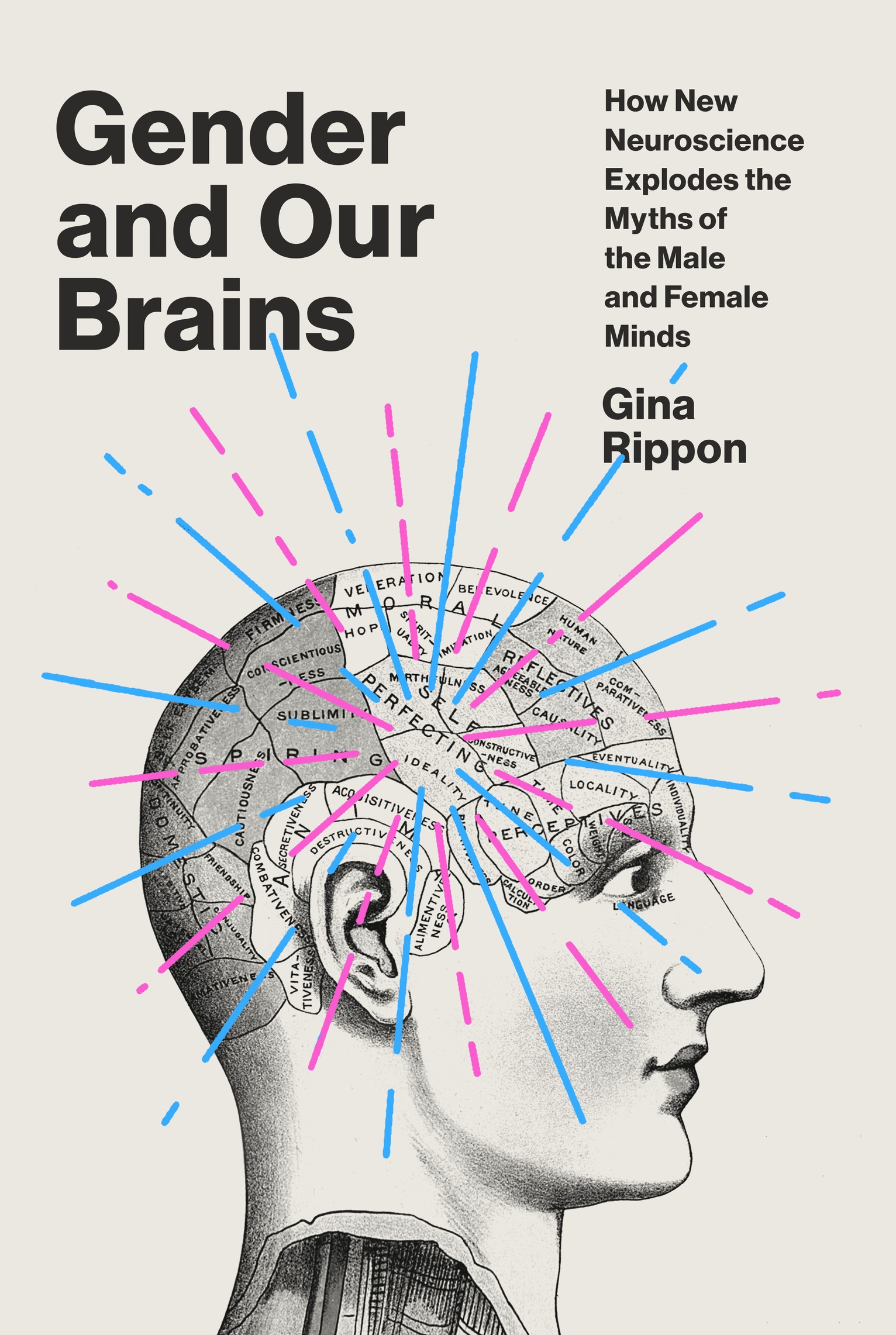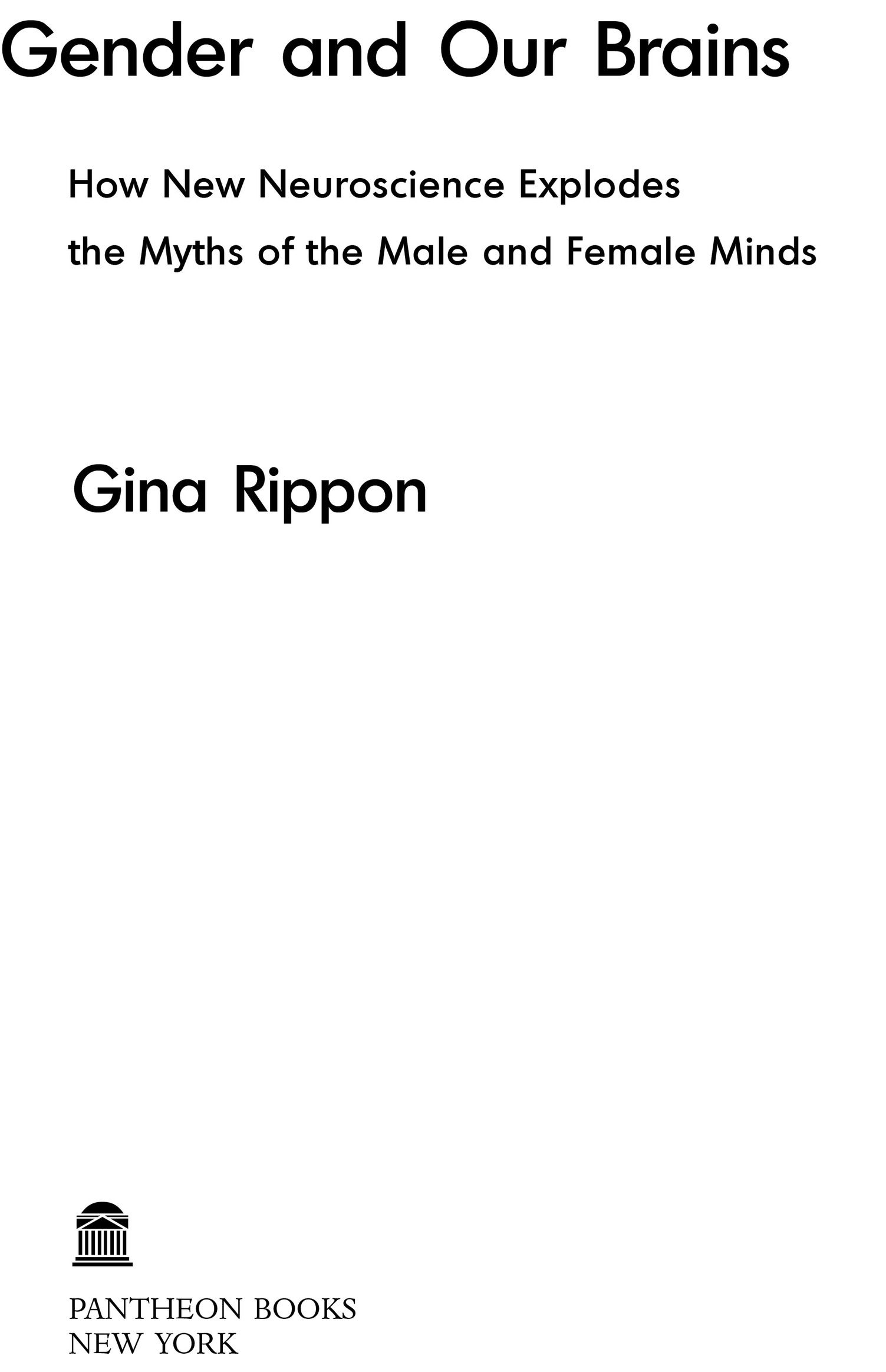Contents
Landmarks
Print Page List
Copyright 2019 by Gina Rippon
All rights reserved. Published in the United States by Pantheon Books, a division of Penguin Random House LLC, New York, and distributed in Canada by Penguin Random House Canada Limited, Toronto. Originally published in hardcover in Great Britain as The Gendered Brain by The Bodley Head, an imprint of Vintage Publishing, a division of Penguin Random House Ltd., London, in 2019.
Pantheon Books and colophon are registered trademarks of Penguin Random House LLC.
Diagrams on by Jeremy Kemp and used under Creative Commons license.
Library of Congress Cataloging-in-Publication Data
Name: Rippon, Gina, author.
Title: Gender and our brains : how new neuroscience explodes the myths of the male and female minds / Gina Rippon.
Description: First United States edition. New York : Pantheon Books, 2019. Includes bibliographical references and index.
Identifiers: LCCN 2019003259. ISBN 9781524747022 (hardcover : alk. paper). ISBN 9781524747039 (ebook).
Subjects: LCSH: Cognitive neuroscience. Gender identity--Research.
Classification: LCC QP360.5 .R57 2019 | DDC 612.8/233--dc23 | LC record available at lccn.loc.gov/2019003259
Ebook ISBN9781524747039
www.pantheonbooks.com
Cover image: Oxford Science Archive/Print Collector/Getty Images
Cover design by Tyler Comrie
v5.4
ep
For Jana and Hildatwo indomitable grandmothers who certainly overrode their Inner Limiters.
For my parents, Peter and Olgawhose love and support gave me so many of the opportunities I have had in my lifes journeyand for my twin brother, Peter, who has been with me along the way.
For Dennispartner, sounding board, sommelier and horticulturalist extraordinaire, with thanks for his tireless patience and support (and lashings of gin).
For Anna and Eleanor, for your future, whatever it might hold.
Few tragedies can be more extensive than the stunting of life, few injustices deeper than the denial of an opportunity to strive or even to hope, by a limit imposed from without, but falsely identified as lying within.
Stephen Jay Gould,
The Mismeasure of Man
Contents
Introduction: Whac-A-Mole Myths
This book is about an idea that has its roots in the eighteenth century and still persists today. That is the notion that you can sex a brain, that you can describe a brain as male or female and that you can attribute any differences between individuals in behavior, abilities, achievements, personality, even hopes and expectations to the possession of one or the other type of brain. It is a notion that has inaccurately driven brain science for several centuries, underpins many damaging stereotypes and, I believe, stands in the way of social progress and equality of opportunity.
The question of sex differences in the brain is one that has been debated, researched, encouraged, criticized, praised and belittled for over 200 years, and can certainly be found in different guises for long before that. It is an area of entrenched opinion and has been the ongoing focus of just about every research discipline from genetics to anthropology, mixed with history, sociology, politics and statistics. It is characterized by bizarre claims (womens inferiority comes from their brains being five ounces lighter) which can readily be dismissed, only to pop up again in another form (womens inability to read maps comes from wiring differences in the brain). Sometimes a single claim lodges itself firmly in the public consciousness as a fact and, despite the best efforts of concerned scientists, remains a deeply entrenched belief. It will be frequently referred to as a well-established fact and triumphantly reemerge to trump arguments about sex differences or, more worryingly, to drive policy decisions.
I think of these seemingly endlessly recurring misconceptions as Whac-A-Mole myths. Whac-A-Mole is an arcade game which involves repeatedly hitting the heads of mechanical moles with a mallet as they pop up through holes in a boardjust when you think youve dispatched them all, another pesky mole pops up elsewhere. The term Whac-A-Mole is used nowadays to describe a process where a problem keeps recurring after it is supposedly fixed, or any discussion where some type of mistaken assumption keeps popping up despite it supposedly having been dispatched by new and more accurate information. In the context of sex differences, this might be the belief that newborn baby boys prefer to look at tractor mobiles rather than human faces (the men are born to be scientists mole), or that there are more male geniuses and more male idiots (the greater male variability mole). Truths such as these have, as we shall see in this book, been variously whacked over the years but can still be found in self-help manuals, how-to guides and even in twenty-first-century arguments about the utility or futility of diversity agendas. And one of the oldest and apparently hardiest of moles is the myth of female and male brains.
The so-called female brain has suffered centuries of being described as undersized, underdeveloped, evolutionarily inferior, poorly organized and generally defective. Further indignities have been heaped upon it as being the cause of womens inferiority, vulnerability, emotional instability, scientific ineptitudemaking them unfit for any kind of responsibility, power or greatness.
Theories about womens inferior brains emerged long before we were actually able to study the human brain, other than when it was damaged or dead. Nevertheless, blame the brain was a consistent and persistent mantra when it came to finding explanations for how and why women were different from men. In the eighteenth and nineteenth centuries it was generally accepted that women were socially, intellectually and emotionally inferior; in the nineteenth and twentieth centuries the focus shifted to womens supposedly natural roles as carers, mothers, womanly companions of men. The message has been consistent: there are essential differences between mens and womens brains, and these will determine their different capacities and characters and their different places in society. Even though we could not test these assumptions, they remained the bedrock on which stereotypes were firmly and immutably grounded.
But at the end of the twentieth century the advent of new forms of brain imaging technology offered the possibility that we could, at last, find out if there really were any differences between the brains of women and those of men, where they might come from, and what they might mean for the brains owners. You might think that the possibilities offered by these new techniques would be seized on as game changers in the arena of research into sex differences and the brain. The development of powerful and sensitive ways for studying the brain, together with a chance to reframe a centuries-old quest for differences, should be revolutionizing the research agenda and galvanizing discussion in media outlets. If only that were the case
Several things went wrong in the early days of sex differences and brain imaging research. With respect to sex differences, there was a frustrating backward focus on historical beliefs in stereotypes (termed neurosexism by psychologist Cordelia Fine). Studies were designed based on the go-to list of the robust differences between females and males, generated over the centuries, or the data were interpreted in terms of stereotypical female/male characteristics which may not have even been measured in the scanner. If a difference was found, it was much more likely to be published than a finding of no difference, and it would also breathlessly be hailed as an at last the truth moment by an enthusiastic media. Finally the evidence that women are hardwired to be rubbish at map reading and that men cant multitask!

